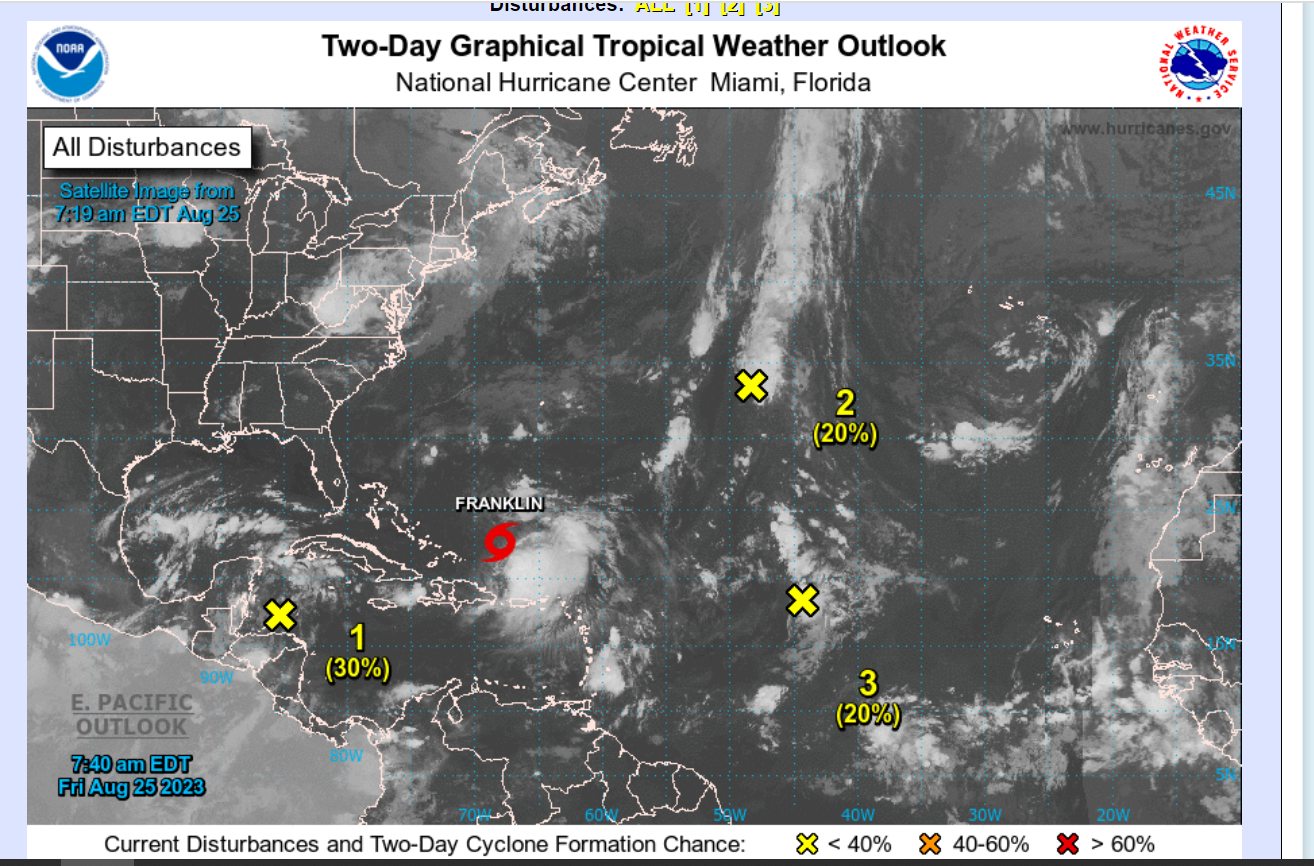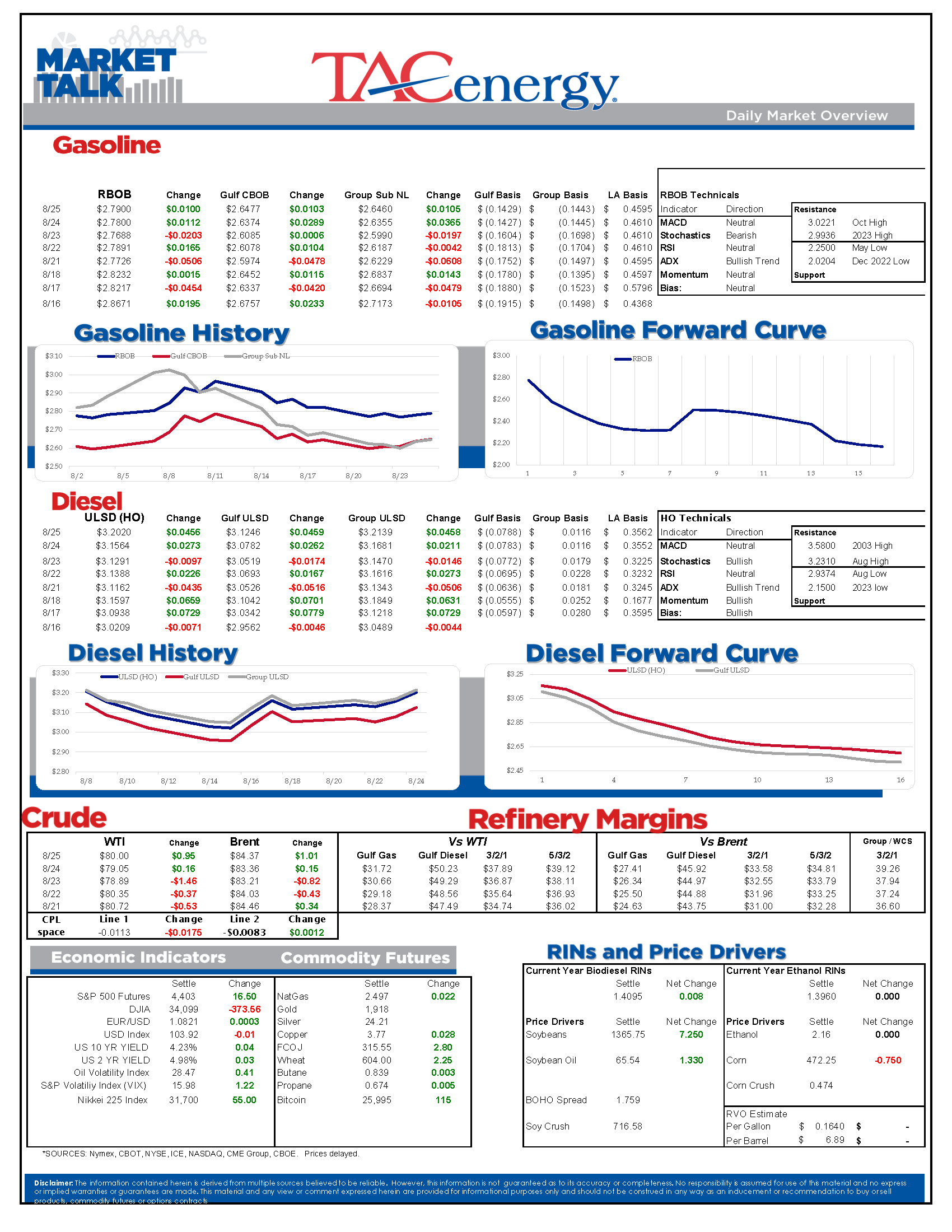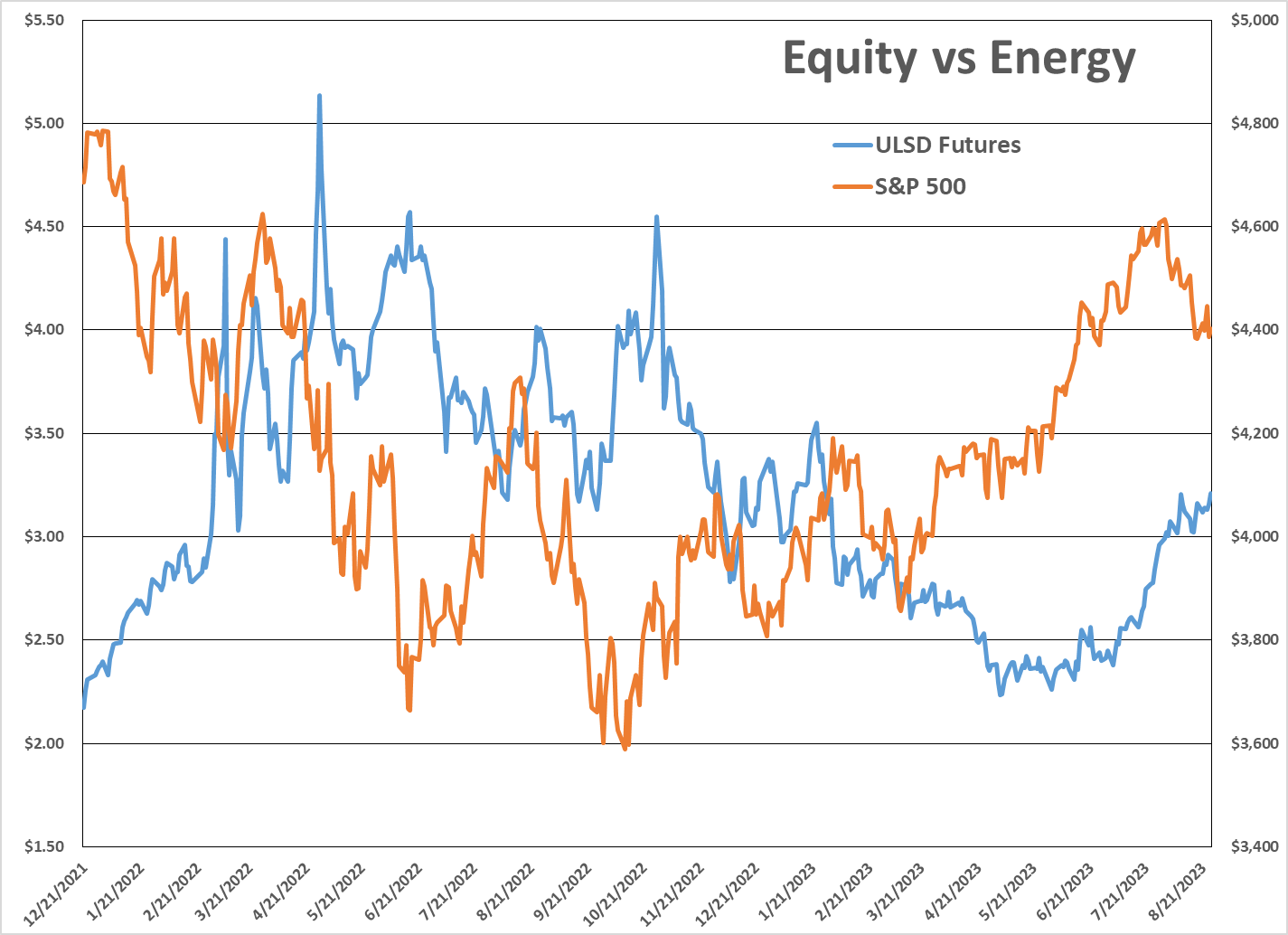The Bulls Look Like They’ve Regained Control Of The Energy Markets Temporarily

The bulls look like they’ve regained control of the energy markets temporarily, with ULSD once again leading the push higher for what will be a 9th straight week of gains if prices can hold above $3.16 today. June 23rd marked the last week when ULSD finished lower, settling at $2.4071 that Friday, vs $3.2005 this morning. Anyone looking for a reason that this might finally be the end of diesel’s summer rally may point to the fact that despite the higher weekly settlements, ULSD prices have not yet broken the high trade of $3.2310 set August 10th.
RBOB futures are up almost a dime from Wednesday’s low but still need to add a couple more cents if they’re to avoid their 2nd straight weekly decline. There are just 5 trading days left in the September RBOB contract which marks the last summer grade spec contract of the year and with October RBOB trading 20 cents lower, this may be the bulls last chance to stage a meaningful run at $3 this year.
The strength in energy futures came despite a big reversal lower in US equity markets Thursday just in time for the FED Chairman’s speech this morning that many think will show that the central bank is still not done with its inflation fighting rate increases. After moving in lockstep earlier this summer, the correlation between daily price moves in energy and equity markets has gone negative in the past 2 weeks.
The NHC is still tracking 4 storm systems in the Atlantic this week, although none look to be a direct threat to the US. Tropical Storm Franklin is expected to reach Category 2 hurricane status next week as it moves north a few hundred miles off the East Coast, which will create some high seas and dangerous currents, but should not be a major factor on supply or demand. The other 3 systems are all given low (20-30%) odds of being named.
Startup troubles: The Cenovus (FKA Husky) refinery in Superior Wisconsin was evacuated for a 2nd straight day Thursday after a leak. No injuries or damage to the recently rebuilt facility were reported but it’s not helping the facilities reputation after it blew up 5 years ago and forced much of the town into an emergency evacuation to avoid toxic fumes.
Haven’t changed their mind: Despite selling multiple refineries in the US in the past few years, just before US refineries had record profits, Shell seems committed to its plans to reduce traditional refining capacity with reports that it will soon be offloading its 237,000 barrel/day plant in Singapore. With numerous new refineries trying to take control of the Asian markets, and a military looking to flex its muscle in the South China Sea, Sinopec’s interest in the facility will no doubt be a topic of much debate in the weeks to come.
Click here to download a PDF of today's TACenergy Market Talk.
News & Views
View All
Energy Prices Are Trading At Multi-Month Lows
Energy prices are trading at multi-month lows and are on the verge of a technical breakdown this morning after Monday’s attempted rally fizzled, and concerns over high inflation and low demand both seem to be keeping buyers at bay.
The complex was trading modestly lower overnight, and then the slide picked up steam following the April Producer Price Index (PPI) report which showed stubbornly high inflation of .5% for the month (which would annualize to 6%) giving the FED another reason to hold off on cutting interest rates. The bright side to this report is that the main contributor to April’s higher inflation reading was higher energy prices, and with the sharp pullback we’ve seen over the past month that component of pricing pressure should come down in the May report.
OPEC continues to bang a bullish drum in its monthly oil market report, increasing its economic estimates for Q1 of this year, and holding its forecasted demand growth steady at 2.8% and 2.9% for 2024 and 2025 respectively. The report also noted big decreases in clean-product tanker rates with east of Suez prices down 10% and West of Suez rates down 20%, in a sign that the physical market is not stressed over the potential shipping disruptions around the Middle East. Refinery margins declined across all major global markets as an end to a busy spring maintenance season and new capacity increased output.
What’s up Doc? The cartel also made a tweak to its monthly report and will now be highlighting output and demand for the countries participating in the Declaration of Cooperation (DoC…aka OPEC & Friends) to demonstrate solidarity and unity, which may signal that some in OPEC are getting nervous that the members may become more uncooperative in the coming months. Total OPEC output dipped by 48mb/day during April with declines in Nigeria and Iraq offsetting increases in Iran and the Congo. Total DoC output declined by 246mb/day during the month with Russia’s output declining by 154mb/day and Kazakhstan’s output down by 50mb/day.
Space on Colonial’s main diesel line (Line 2) settled in positive territory for the first time this year, as the building contango for distillates helps to incentivize shippers. There also appears to be another buildup of un-wanted inventory of distillates in several regional markets with basis values in LA, Chicago and the Group 3 market all reaching multi-month lows this week.
Some of the weakness in diesel prices can be blamed on recent wet weather delaying planting in several states, and those delays are also helping corn and ethanol prices rebound to approach their highest levels of the year.
New tariffs on Chinese EV’s are making headlines this week, but it’s a potential tariff on Used Cooking Oil (UCO) from China that could have a larger impact near term on the fuel industry as US grain processor think it’s unfair that China dares recycle oil to the detriment of their food to fuel factories.
Speaking of EV’s, the EIA this morning wrote that the US share of electric and hybrid vehicle sales decreased on the first quarter of 2024 after more than 3 years of steady growth.
Click here to download a PDF of today's TACenergy Market Talk.

Struggling Energy Markets Searching For Stability
Energy markets are still trying to find a floor after a weak finish Friday left refined products at their lowest weekly closing level in several months. For RBOB futures, Friday’s drop left the contract at its lowest level since February, when the prompt contract was a winter spec that traded roughly 25 cents below the current summer values. That slide on the weekly charts leaves the contract in perilous technical territory with a slide into the $2.20 range likely if buyers can’t maintain the current push back north of the $2.50 mark this week. ULSD futures ended the week at their lowest since last July, and a similar slide towards $2.20 appears to have a good probability if the early buying today isn’t sustained. That said, both contracts are in oversold technical territory on the daily charts, so a bigger bounce is certainly possible.
Ukraine carried out more drone strikes on Russian energy assets over the weekend, with the Lukoil Volgograd refinery reportedly forced to take units offline. That facility was also hit by a strike back in February, and reported it was back at full rates in April. In addition, strikes were reported at a fuel depot outside Moscow that serves 3 local refineries.
A week ago, it looked like the cycle of hedge fund liquidation in energy contracts had run its course, but the latest CFTC data showed more heavy selling by money managers across the energy complex as of last Tuesday with a new decrease in bets on higher prices of more than 120,000 contracts. New short bets on crude oil contracts were also a theme for the week as the money manager category continues to show itself as the momentum chasers as those bets decided to wait until after prices had dropped $10/barrel over the prior month to decide to bet on lower prices. Based on the soft finish to end last week, it seems likely there was more selling from hedge funds that we’ll see in this week’s CFTC report, although the volume is probably less than the most recent report.
Baker Hughes reported a net decrease of 3 oil rigs drilling in the US last week while natural gas rigs increased by 1. Natural gas prices in the US had a healthy rally to a 3-month high last week after a brutal quarter for producers. It’s worth noting that the rally in US natural gas prices far outpaced the stagnant price moves of the main European contract, which suggests that the US market is starting to price in an increase in LNG exports while Europe maintains healthy supplies, in stark contrast to the market of 2 years ago when a dire supply situation in Europe created huge price swings in both US natural gas and diesel prices.
The EIA this morning highlighted how Brazil led a shift in countries buying Russian diesel exports over the past year, which has helped maintain the country’s product and cash flows despite widespread sanctions. The data provided showed an increase in year-on-year diesel exports as of March, which is when the refinery strikes picked up their pace, so we’ll still need to wait a while longer to get a good read on the direct impact of those strikes.
Chevron Pasadena, Valero Pt Arthur and Delek Big Spring all reported upsets to the TCEQ over the weekend, although none of the facilities appear to have had to reduce run rates as a result. The Big Spring filing noted a lightning strike as the cause of the upset, adding to the long list of weather woes at that facility.
Click here to download a PDF of today's TACenergy Market Talk.

Prices Continue To Move In A Relatively Tight Range Awaiting The Next Big Move
Energy markets are treading water heading towards the weekend after Thursday’s rally attempt fizzled and prices continue to move in a relatively tight range awaiting the next big move.
Ukraine struck another Russian refinery overnight, this one a small facility outside of Moscow that was previously hit in March. Yesterday a new type of Ukrainian drone set a record for distance traveled inside of Russia to strike another larger refinery far away from the border. These strikes don’t seem to be stirring market sentiment as they did a couple of months ago as the global market seems to be doing just fine without the incremental Russian barrels for now.
P66 reported unplanned flaring at its Wilmington CA refinery overnight. Since the AQMD doesn’t require the units to be named in the filings it's unclear what impact this may have on production or basis values in the LA-area, which have been the weakest on the West Coast lately as the region struggles with an oversupply of diesel and is less tight on gasoline than its peers.
Citgo continued to report quarterly earnings as it tries to convince bidders that they’re worth years of legal wrangling that’s sure to come along with the auction of its assets. The company had strong run rates of near 95% for the quarter at its 3 plants, and earnings were healthy at $709 million in EBITDA, which was half of year-ago levels.
The biggest story of Thursday’s earnings reports came from the smallest refinery as Vertex announced it was pausing renewable diesel output at its Mobile plant in an effort to survive its liquidity crisis. The company is currently struggling under a mountain of debt including a $196 million term loan that’s costing 17.25% interest as lenders are commanding a huge premium to take risk with the firm.
RBN Energy published an article on Renewable Diesel’s huge reliance on subsidies that helps explain why so many biodiesel and RD producers are cutting production as RIN values and LCFS credits tank. With the change in the blenders tax credit coming next year, those economics are expected to get even worse.
Click here to download a PDF of today's TACenergy Market Talk.



